Energy Storage as a Transmission Asset—Assessing the Multiple Uses of a Utility-Scale Battery Energy Storage System in Brazil
Abstract
:1. Introduction
2. Literature Overview of Storage for Transmission Support
- Deployment time is on the order of months rather than years, which introduces a certain degree of robustness due to the increased response speed to changes.
- Easy installation, being relatively independent of terrain characteristics, and even representing an alternative when other storage technologies, such as pumped hydro, are not convenient due to the lack of appropriate site conditions.
- Fewer uncertainties, making the associated costs less sensitive to project specifics for the same power and energy storage capacity.
- Greater modularity, allowing for more flexibility in meeting needs and adjusting power and storage capacity if necessary.
- The effects can propagate along the network avoiding congestion in several transmission lines due to the ability to displace energy in time, such as the case studied in [3], and also the case to be presented in this work in the city of Registro, Brazil.
3. Case Study Description: The 30 MW/60 MWh BESS in Registro, Brazil
4. Assessing Multiple Uses for the Registro BESS
4.1. Operational Flexibility Under Contingencies and Maintenance
4.2. Islanded Operation
4.3. System Restoration
4.4. Integration of Renewables
5. Case Study Results
5.1. Case 1: Operational Flexibility Under Contingencies and Maintenance
5.2. Case 2: Islanded Operation
5.3. Case 3: System Restoration
5.4. Case 4: Integration of Renewables
6. Conclusions
Author Contributions
Funding
Data Availability Statement
Acknowledgments
Conflicts of Interest
References
- NREL. Cost Projections for Utility-scale Battery Storage: 2023 Update. 2023. Available online: https://www.nrel.gov/docs/fy23osti/85332.pdf (accessed on 15 January 2025).
- Virgens, N.S.A. Inserção da Estimação do Nível de Inércia no Planejamento da Expansão dos Sistemas de Transmissão de Energia Elétrica. 2023. Available online: https://repositorio.ufsc.br/handle/123456789/251411?show=full (accessed on 15 January 2025).
- Luburić, Z.; Pandžić, H.; Plavšić, T.; Teklić, L.; Valentić, V. The role of energy storage in ensuring transmission system adequacy and security. Energy 2018, 156, 229–239. [Google Scholar] [CrossRef]
- Quanta Technology. Storage as Transmission Asset Market Study. 2023. Available online: https://cdn.ymaws.com/ny-best.org/resource/resmgr/reports/SATA_White_Paper_Final_01092.pdf (accessed on 15 January 2025).
- Zhao, C.; Andersen, P.B.; Traeholt, C.; Hashemi, S. Grid-connected battery energy storage system: A review on application and integration. Renew. Sustain. Energy Rev. 2023, 182, 113400. [Google Scholar] [CrossRef]
- Mirzapour, O.; Rui, X.; Sahraei-Ardakani, M. Grid-enhancing technologies: Progress, challenges, and future research directions. Electr. Power Syst. Res. 2024, 230, 110304. [Google Scholar] [CrossRef]
- Kemp, J.; Millstein, D.; Kim, J.; Wiser, R. Interactions between hybrid power plant development and local transmission in congested regions. Adv. Appl. Energy 2023, 10, 100133. [Google Scholar] [CrossRef]
- AhmadiAhangar, R.; Plaum, F.; Haring, T.; Drovtar, I.; Korotko, T.; Rosin, A. Impacts of grid-scale battery systems on power system operation_case of the baltic region. IET Smart-Grid 2024, 7, 101–119. [Google Scholar] [CrossRef]
- Virasjoki, V.; Rocha, P.; Siddiqui, A.; Salo, A. Market Impacts of Energy Storage in a Transmission-Constrained Power System. IEEE Trans. Power Syst. 2016, 31, 4108–4117. [Google Scholar] [CrossRef]
- Numan, M.; Asif, M.; Khan, M.; Malik, S.; Khilji, F. Impact of Dynamic Thermal Rating on optimal siting and sizing of energy storage systems under Renewable Portfolio Standards requirements. Sustain. Energy Grids Netw. 2021, 32, 100881. [Google Scholar] [CrossRef]
- Saber, H.; Moeini-Aghtaie, M.; Ehsan, M. Developing a multi-objective framework for expansion planning studies of distributed energy storage systems (DESSs). Energy 2018, 157, 1079–1089. [Google Scholar] [CrossRef]
- Ansaripour, R.; Barati, H.; Ghasemi, A. Multi-objective chance-constrained transmission congestion management through optimal allocation of energy storage systems and TCSC devices. Electr. Eng. 2022, 104, 4049–4069. [Google Scholar] [CrossRef]
- Chabok, H.; Aghaei, J.; Sheikh, M.; Roustaei, M.; Zare, M.; Niknam, T.; Lehtonen, M.; Shafi-khah, M.; Catalao, J. Transmission-constrained optimal allocation of price-maker wind-storage units in electricity markets. Appl. Energy 2022, 310, 118542. [Google Scholar] [CrossRef]
- Yang, X.; Chai, G.; Liu, X.; Xu, M.; Guo, Q. Storage-Transmission Joint Planning Method to Deal with Insufficient Flexibility and Transmission Congestion. Front. Energy Res. 2021, 8, 612909. [Google Scholar] [CrossRef]
- Vargas, L.; Bustos-Turu, G.; Larrain, F. Wind Power Curtailment and Energy Storage in Transmission Congestion Management Considering Power Plants Ramp Rates. IEEE Trans. Power Syst. 2015, 30, 1–9. [Google Scholar] [CrossRef]
- Agüero, M.; Peralta, J.; Quintana, E.; Velar, V.; Stepanov, A.; Ashourian, H.; Mahseredjian, J.; Cárdenas, R. Virtual Transmission Solution Based on Battery Energy Storage Systems to Boost Transmission Capacity. J. Mod. Power Syst. Clean Energy 2024, 12, 466–474. [Google Scholar] [CrossRef]
- Xu, Y.; Singh, C. Power System Reliability Impact of Energy Storage Integration With Intelligent Operation Strategy. IEEE Trans. Smart Grid 2014, 5, 1129–1137. [Google Scholar] [CrossRef]
- Ponocko, J.; Mateska, A.; Krstevski, P. Cross-border DSM as a complement to storage and RES in congestion management markets. Int. J. Electr. Power Energy Syst. 2023, 148, 108917. [Google Scholar] [CrossRef]
- Zhao, Z.; Wang, C.; Nazari, M. Revenue Analysis of Stationary and Transportable Battery Storage for Power Systems: A Market Participant Perspective. Sustainability 2024, 16, 2370. [Google Scholar] [CrossRef]
- Moreira, R.; Moreno, R.; Strbac, G. Value of corrective network security for distributed energy storage applications. IET Gener. Transm. Distrib. 2016, 10, 1758–1767. [Google Scholar] [CrossRef]
- Elliott, R.; Fernández-Blanco, R.; Kozdras, K.; Kaplan, J.; Lockyear, B.; Zyskowski, J.; Kirschen, D. Sharing Energy Storage Between Transmission and Distribution. IEEE Trans. Power Syst. 2019, 34, 152–162. [Google Scholar] [CrossRef]
- Dvorkin, Y.; Fernández-Blanco, R.; Kirschen, D.; Pandzic, H.; Watson, J.; Silva-Monroy, C. Ensuring Profitability of Energy Storage. IEEE Trans. Power Syst. 2017, 32, 611–623. [Google Scholar] [CrossRef]
- Khani, H.; Zadeh, M.; Hajimiragha, A. Transmission Congestion Relief Using Privately Owned Large-Scale Energy Storage Systems in a Competitive Electricity Market. IEEE Trans. Power Syst. 2015, 31, 1449–1458. [Google Scholar] [CrossRef]
- Arteaga, J.; Zareipour, H.; Amjady, N. Energy Storage as a Service: Optimal sizing for Transmission Congestion Relief. Appl. Energy 2021, 298, 117095. [Google Scholar] [CrossRef]
- Tarashandeh, N.; Karimi, A. Utilization of energy storage systems in congestion management of transmission networks with incentive-based approach for investors. J. Energy Storage 2021, 33, 102034. [Google Scholar] [CrossRef]
- Khastieva, D.; Mohammadi, S.; Hesamzadeh, M.; Bunn, D. Optimal Transmission Investment With Regulated Incentives Based Upon Forward Considerations of Firm and Intermittent Resources With Batteries. IEEE Trans. Power Syst. 2021, 36, 4420–4434. [Google Scholar] [CrossRef]
- Nanou, S.; Psarros, G. Optimal dispatch of BESS-fed virtual power lines under transmission congestion and bulk renewable generation. Electr. Power Syst. Res. 2024, 229, 110196. [Google Scholar] [CrossRef]
- Wang, S.; Geng, G.; Jiang, Q. Robust Co-Planning of Energy Storage and Transmission Line With Mixed Integer Recourse. IEEE Trans. Power Syst. 2019, 34, 4728–4738. [Google Scholar] [CrossRef]
- Taylor, J. Financial Storage Rights. IEEE Trans. Power Syst. 2015, 30, 997–1005. [Google Scholar] [CrossRef]
- Arteaga, J.; Zareipour, H.; Amjady, N. Energy Storage as a Service: Optimal Pricing for Transmission Congestion Relief. IEEE Open Access J. Power Energy 2020, 7, 514–523. [Google Scholar] [CrossRef]
- Lindner, M.; Peper, J.; Offermann, N.; Biele, C.; Teodosic, M.; Pohl, O.; Menne, J.; Häger, U. Operation strategies of battery energy storage systems for preventive and curative congestion management in transmission grids. IET Gener. Transm. Distrib. 2022, 17, 589–603. [Google Scholar] [CrossRef]
- Liere-Netheler, I.; Schuldt, F.; von Maydell, K.; Agert, C. Technical and economic analysis of curative actions in distribution networks utilizing battery energy storage systems. IET Gener. Transm. Distrib. 2022, 16, 724–736. [Google Scholar] [CrossRef]
- Prajapati, V.; Mahajan, V.; Padhy, N. Congestion management of integrated transmission and distribution network with RES and ESS under stressed condition. Int. Trans. Electr. Energy Syst. 2021, 31, e12757. [Google Scholar] [CrossRef]
- MME. NOTA TÉCNICA Nº 37/2024/DPOG/SNTEP. 2024. Available online: https://antigo.mme.gov.br/c/document_library/get_file?uuid=701b303d-0511-ae95-d02f-9b2e7a0ab8db&groupId=436859 (accessed on 23 January 2025).
- Presidência da Reública. LEI Nº 9.648, DE 27 DE MAIO DE 1998. Art 9. Available online: https://www.planalto.gov.br/ccivil_03/leis/L9648cons.htm (accessed on 15 January 2025).
- Presidência da República. LEI Nº 9.074, DE 7 DE JULHO DE 1995. Art 15. Available online: https://www.planalto.gov.br/ccivil_03/leis/l9074cons.htm (accessed on 15 January 2025).
- ANEEL. Regulamentação para o Armazenamento de Energia Elétrica, incluindo Usinas Hidrelétricas Reversíveis. 2023. Available online: https://www2.aneel.gov.br/cedoc/air2023001sgm.pdf (accessed on 15 January 2025).
- ANEEL. RESOLUÇÃO AUTORIZATIVA Nº 10.892, DE 16 DE NOVEMBRO DE 2021. 2021. Available online: https://www2.aneel.gov.br/cedoc/rea202110892ti.pdf (accessed on 15 January 2025).
- ONS. “Plano da Operação Elétrica de Médio Prazo do SIN – Ciclo 2025-2029: Termo de Referência. RT-NOS DPL 0030/2024”, Rio de Janeiro, Brazil, 2024. Available online: https://www.ons.org.br/AcervoDigitalDocumentosEPublicacoes/Revista%20PARPEL%20_2024_VF_27.12.24.pdf (accessed on 23 January 2025).
- ONS. Submódulo 2.10-Requisitos Técnicos Mínimos para Conexão às Instalações de Transmissão. 2022. Available online: https://www2.aneel.gov.br/cedoc/adsp20233717_2.pdf (accessed on 15 January 2025).
- ONS. “Resultados da Operação – Dados de Geração Eólica e Solar Comparativo do Fator de Capacidade Médio Horário por Usina”. 2024. Available online: https://www.ons.org.br/Paginas/resultados-da-operacao/historico-da-operacao/geracao-fator-capacidade-medios-mensais.aspx (accessed on 23 January 2025).
- ONS. Gerenciamento da Carga por Atuação do ERAC. IO-GC.BR.02, r. 22, i. 3.5. 2024. Available online: https://www.ons.org.br/%2FMPO%2FDocumento%20Normativo%2F3.%20Instru%C3%A7%C3%B5es%20de%20Opera%C3%A7%C3%A3o%20-%20SM%205.12%2F3.5.%20Gerenciamento%20da%20Carga%2FIO-GC.BR.02_Rev.22.pdf (accessed on 23 January 2025).
- Abdeltawab, H.H.; Mohamed, Y.A.I. The Potential of Mobile Energy Storage in Microgrids. IEEE: NewYork, NY, USA, 2020; pp. 1864–1870. [Google Scholar] [CrossRef]
- Abdeltawab, H.; Mohamed, Y.A.R.I. Mobile Energy Storage Sizing and Allocation for Multi-Services in Power Distribution Systems. IEEE Access 2019, 7, 176613–176623. [Google Scholar] [CrossRef]
- Kwon, S.Y.; Park, J.Y.; Kim, Y.J. Optimal Operation of Mobile Energy Storage Devices to Minimize Energy Loss in a Distribution System. In Proceedings of the 2018 IEEE Int Conf Environ Electr Eng 2018 IEEE Ind Commer Power Syst Eur EEEIC/I CPS Eur 2018, Palermo, Italy, 12–15 June 2018. [Google Scholar] [CrossRef]
- ANEEL. Acompanhamento Diferenciado da Expansão da Transmissão. Technical Report. 2022. Available online: https://git.aneel.gov.br/publico/centralconteudo/-/blob/main/relatorioseindicadores/transmissao/relacompdifexpt/202203_RAD_Trimetral.pdf (accessed on 23 January 2025).
- IRENA. Electricity Storage Valuation Framework: Assessing System Value and Ensuring Project Viability. Abu Dhabi. 2020. Available online: https://www.irena.org/-/media/Files/IRENA/Agency/Publication/2020/Mar/IRENA_storage_valuation_2020.pdf (accessed on 15 January 2025).
- Denholm, P.; Mai, T. Timescales of energy storage needed for reducing renewable energy curtailment. Renew Energy 2019, 130, 388–399. [Google Scholar] [CrossRef]
- Fidalgo, J.N.; Couto, M.; Fournié, L. The worth of network upgrade deferral in distribution systems—Truism or myth? Electr. Power. Syst. Res. 2016, 137, 96–103. [Google Scholar] [CrossRef]
- Mostert, C.; Ostrander, B.; Bringezu, S.; Kneiske, T.M. Comparing electrical energy storage technologies regarding their material and carbon footprint. Energies 2018, 11, 3386. [Google Scholar] [CrossRef]
- Dehghani-Sanij, A.R.; Tharumalingam, E.; Dusseault, M.B.; Fraser, R. Study of energy storage systems and environmental challenges of batteries. Renew. Sustain. Energy Rev. 2019, 104, 192–208. [Google Scholar] [CrossRef]
- Arciniegas, L.M.; Hittinger, E. Tradeoffs between revenue and emissions in energy storage operation. Energy 2018, 143, 1–11. [Google Scholar] [CrossRef]
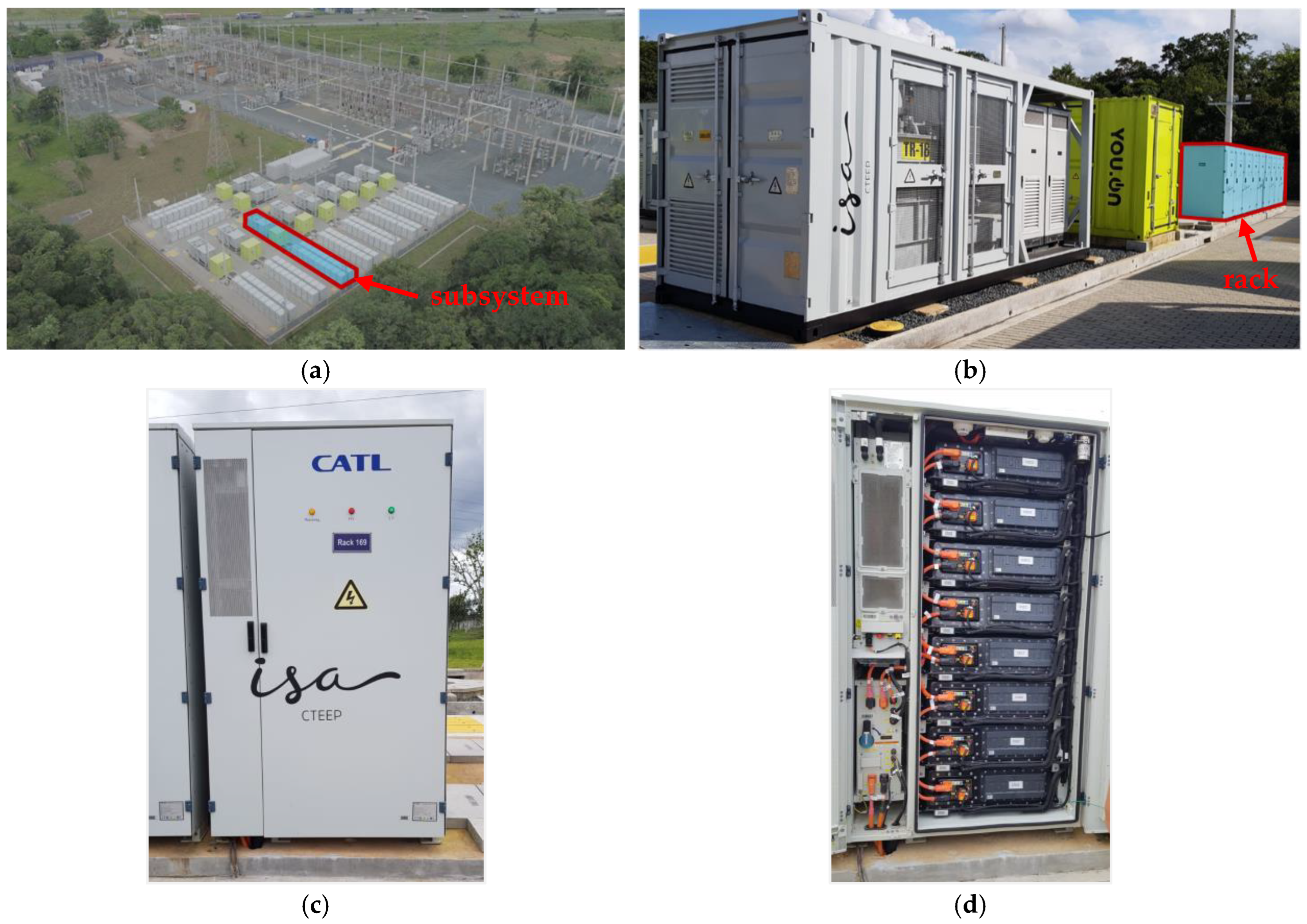


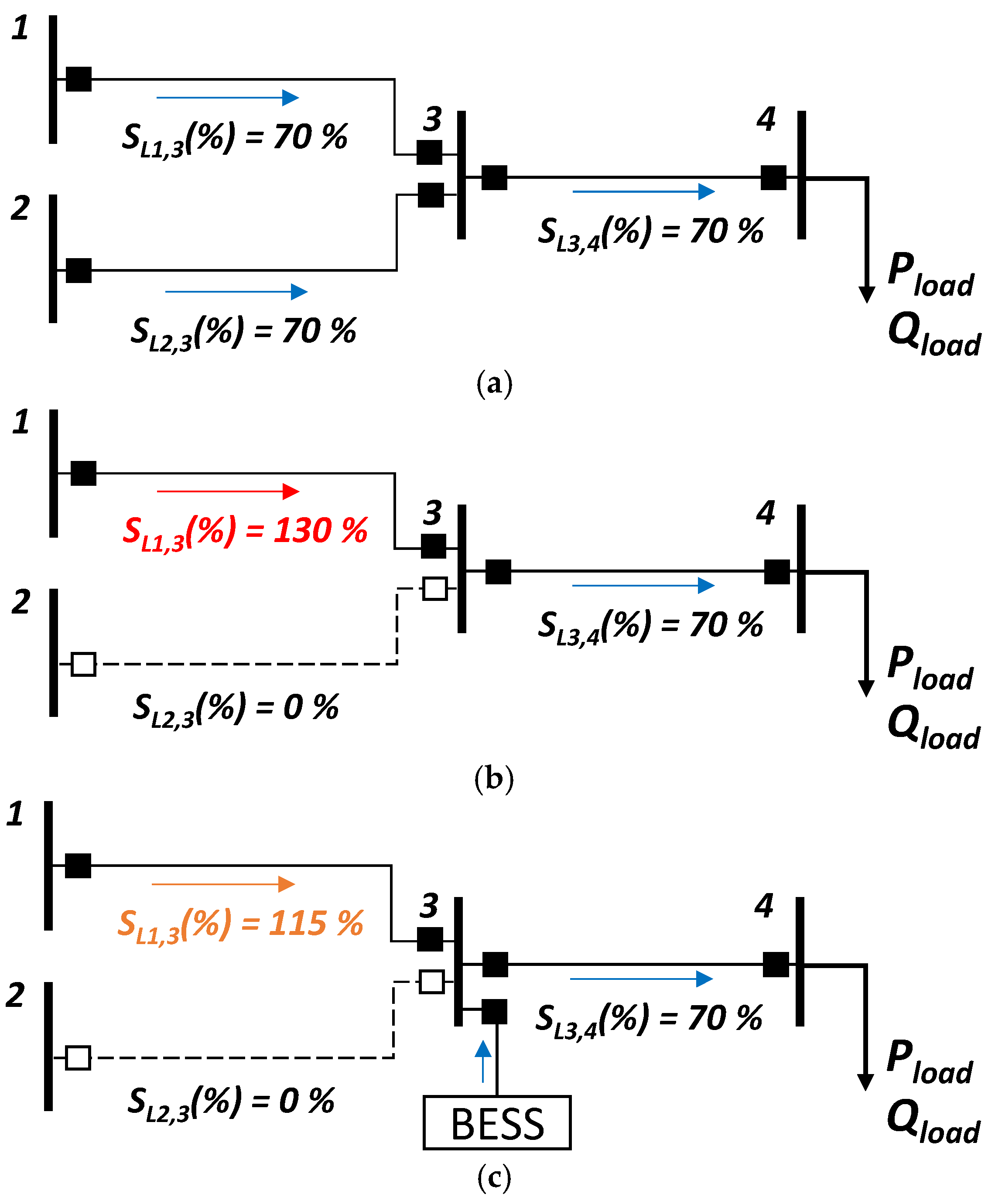
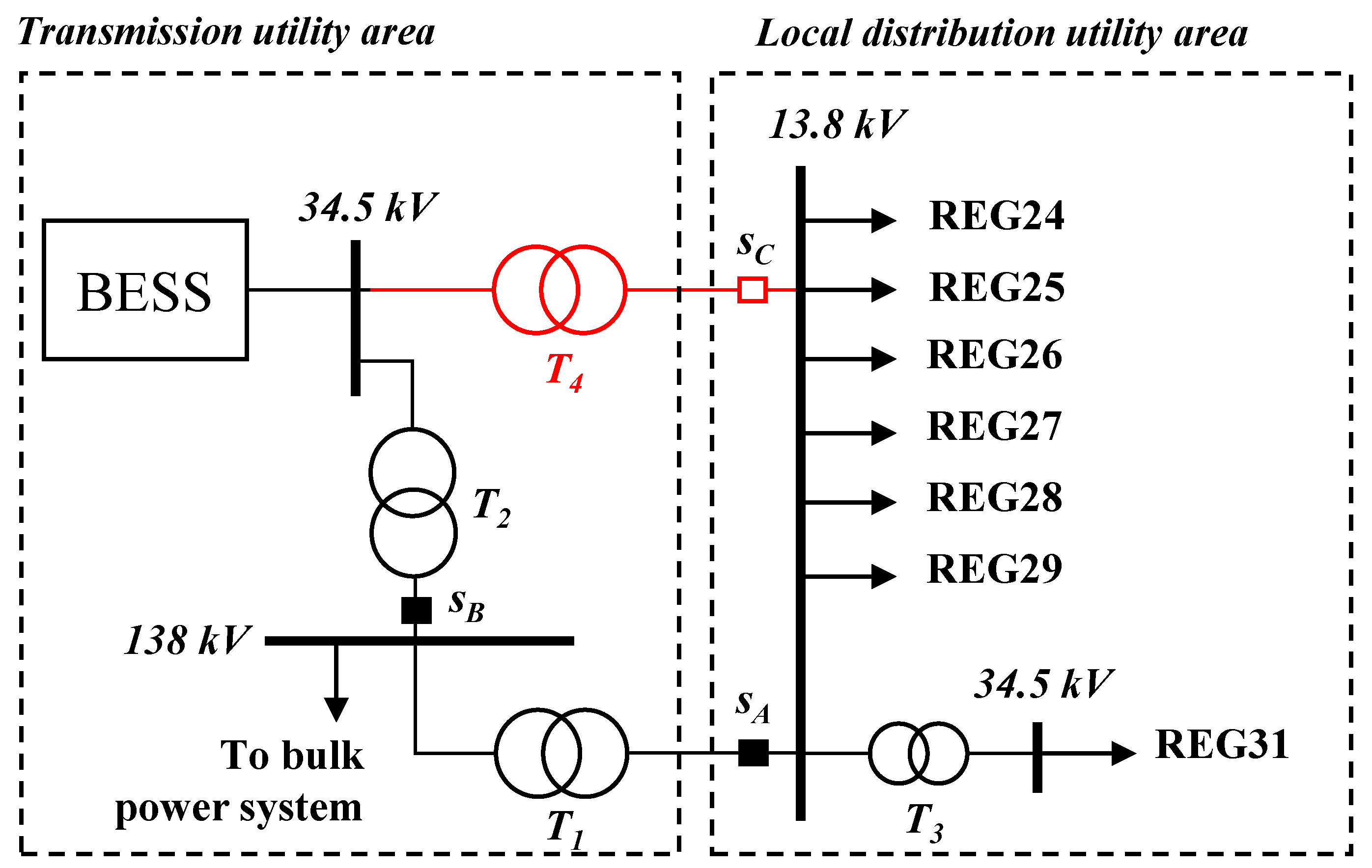



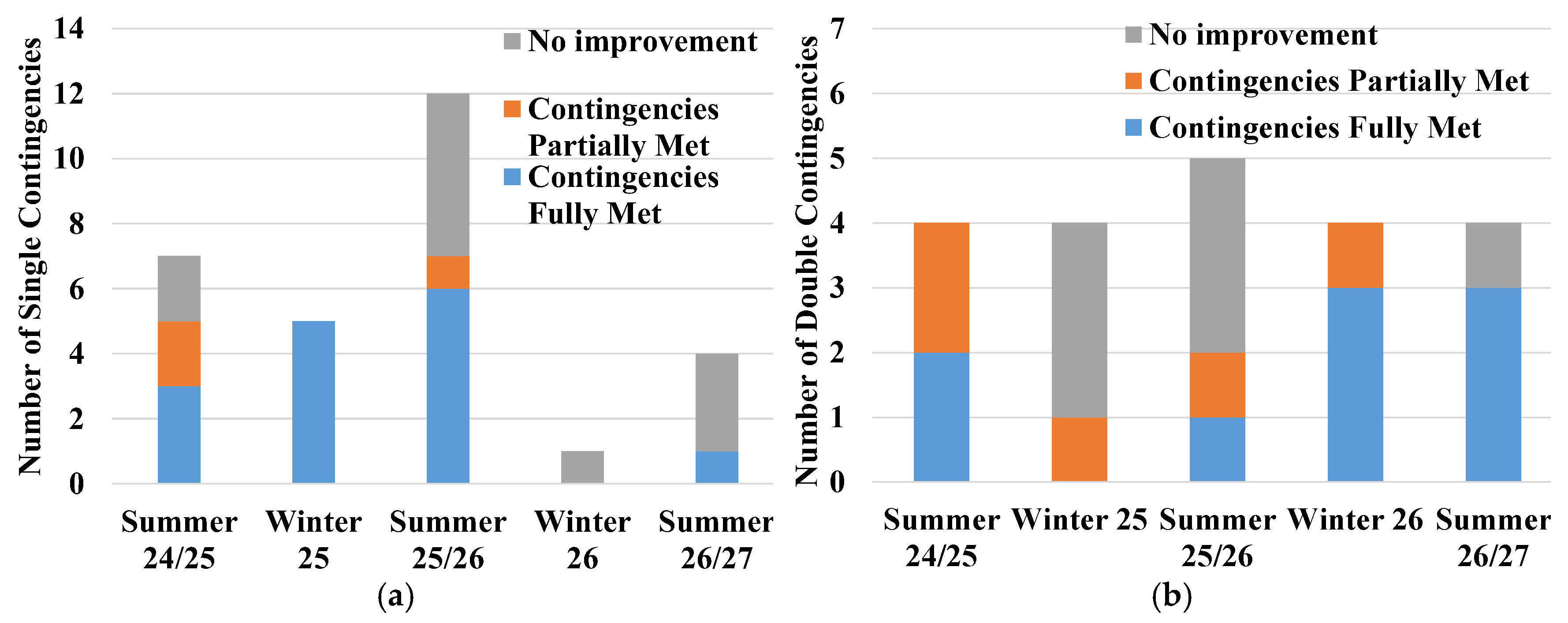





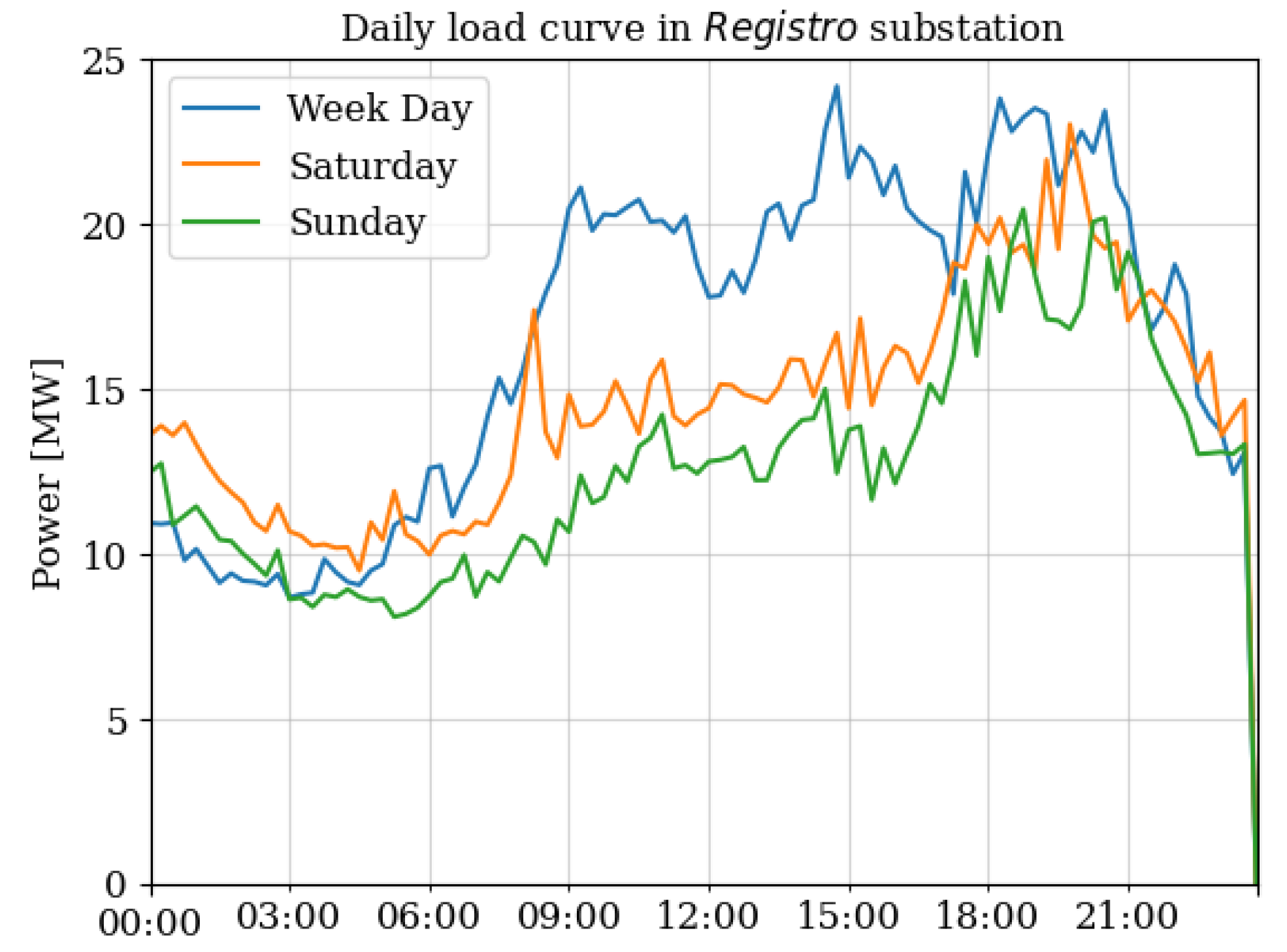
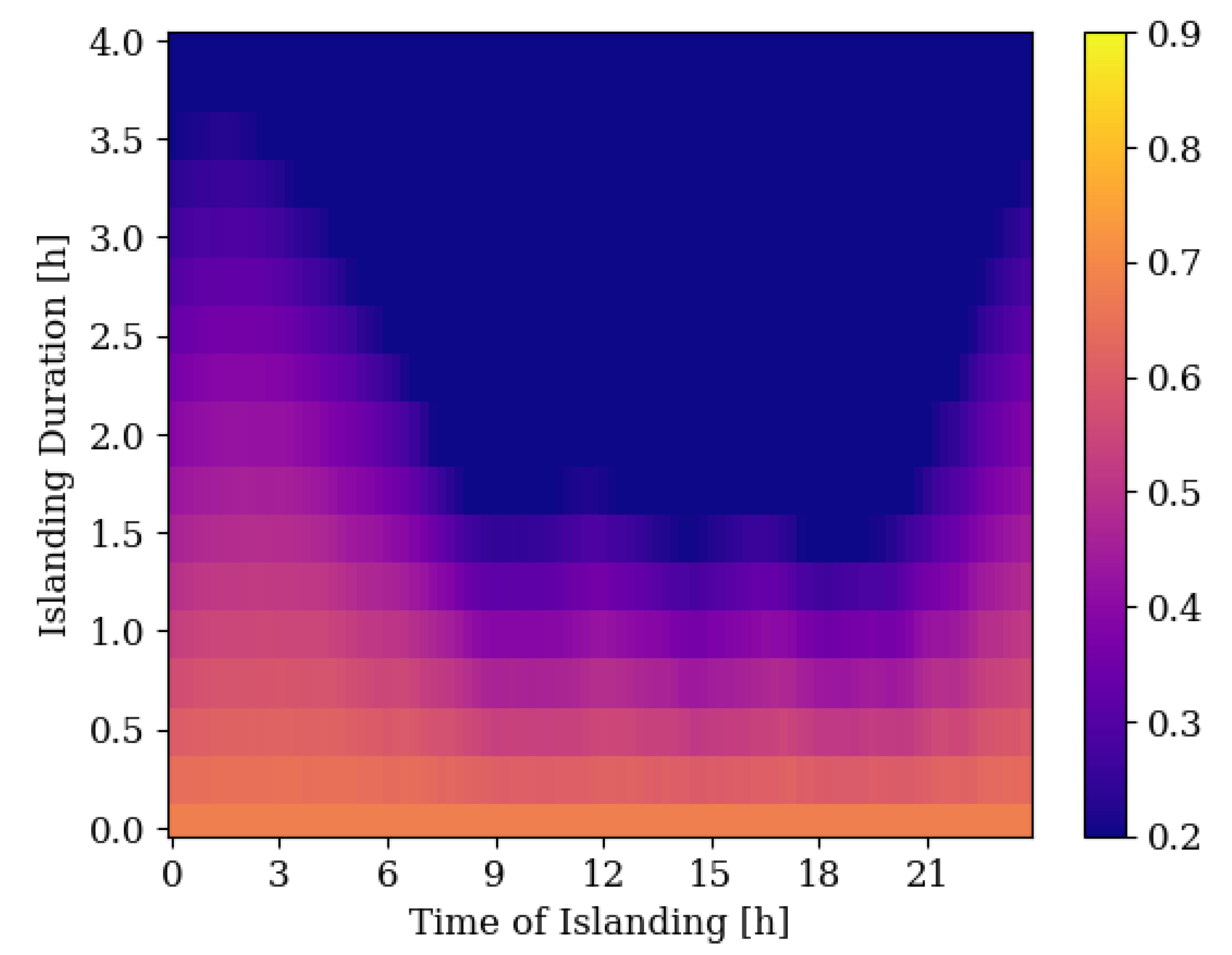


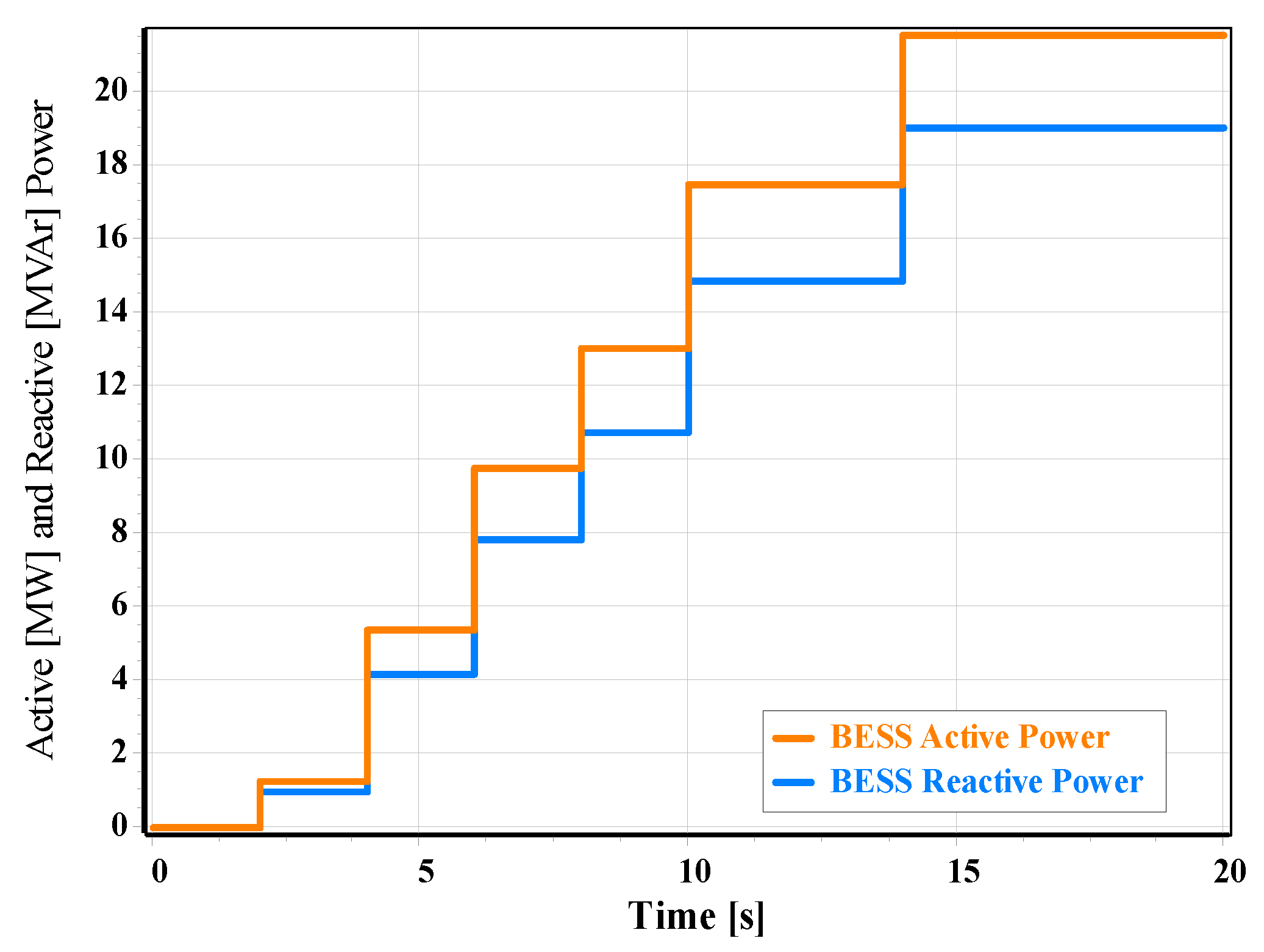


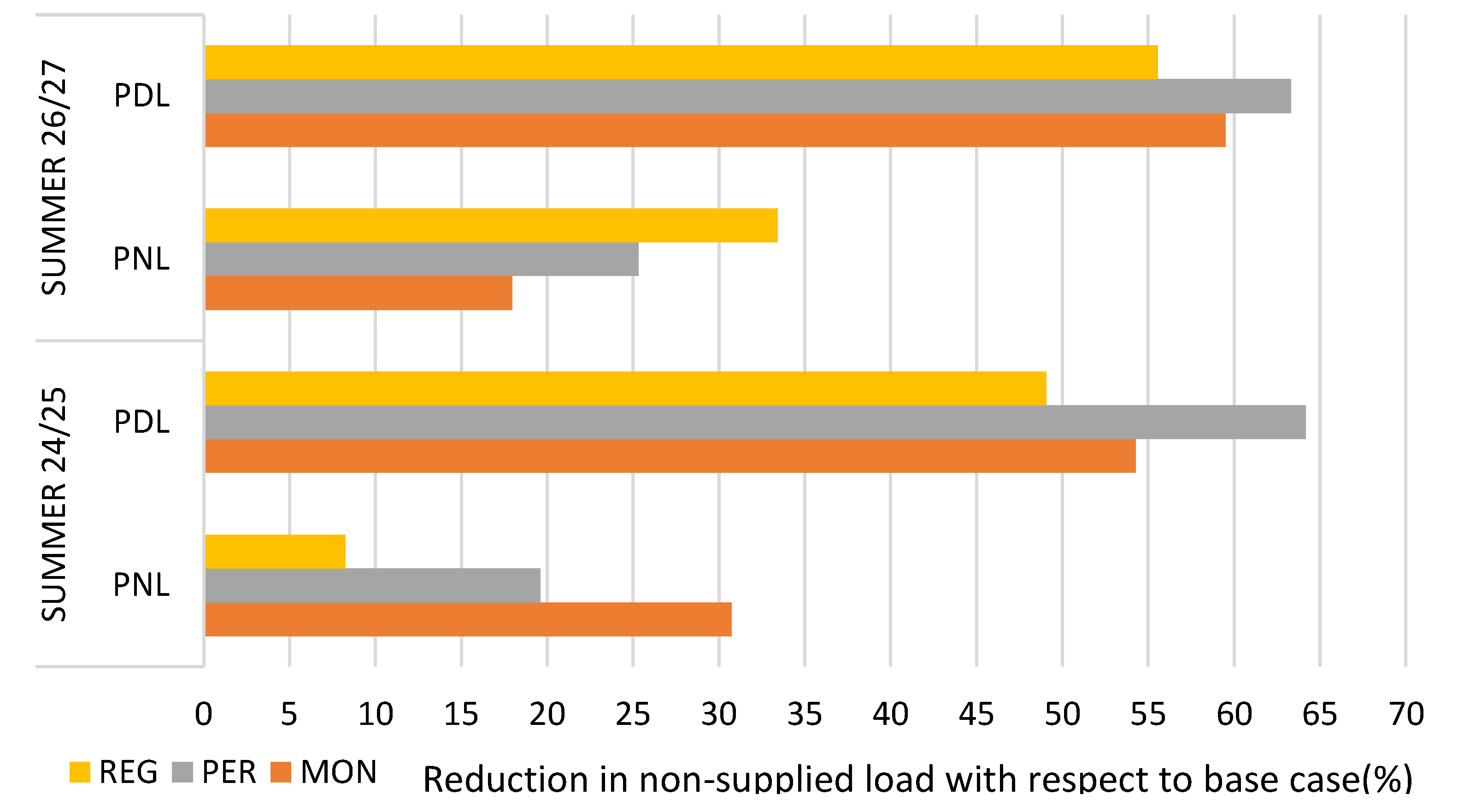


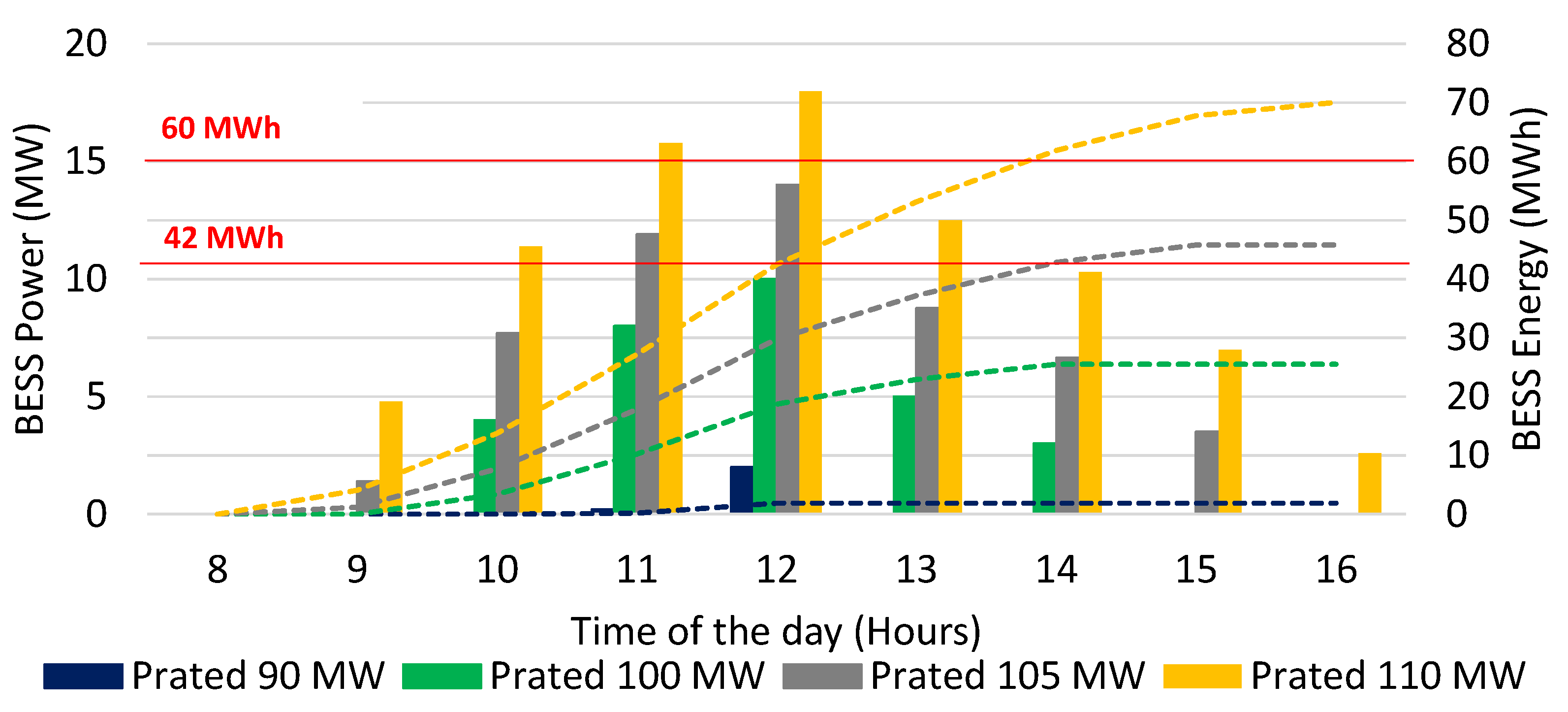
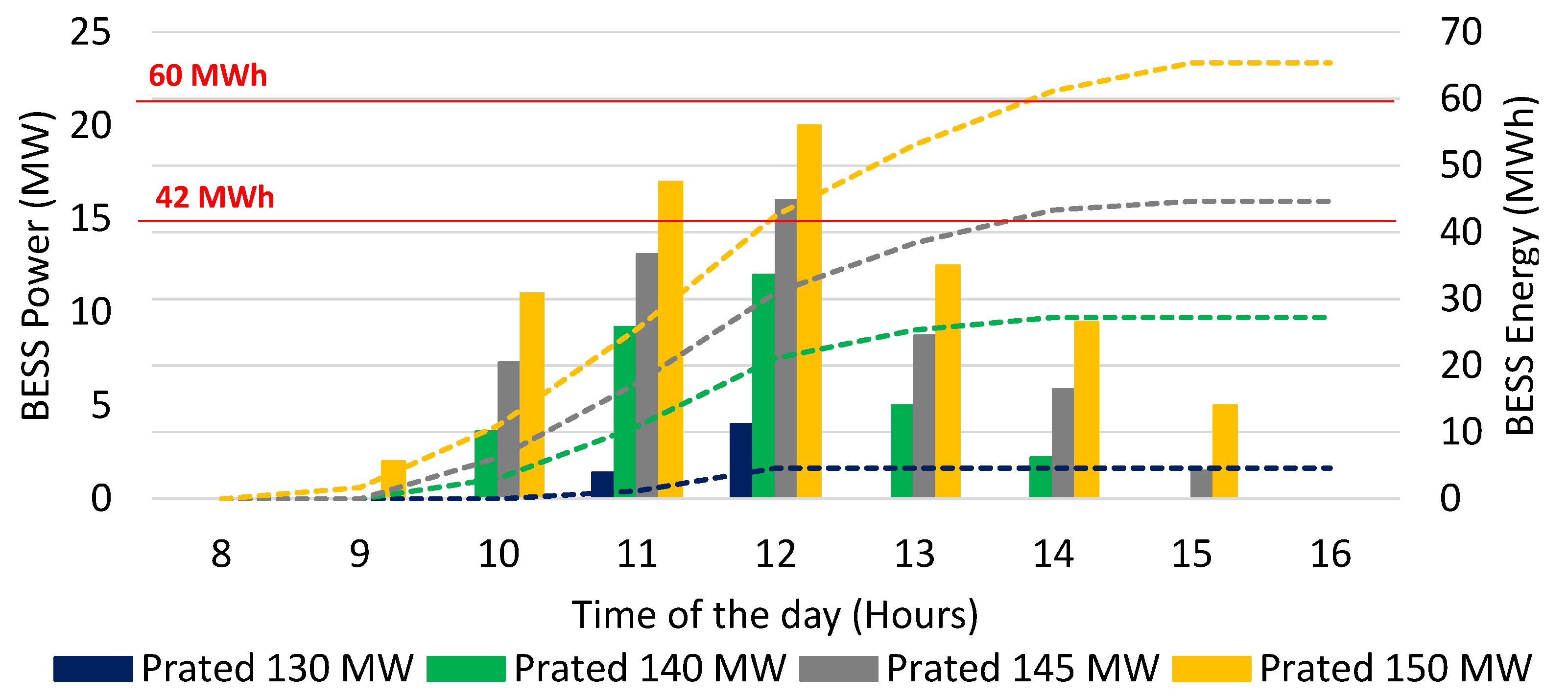
| Case Description | Event | Scenarios |
|---|---|---|
| Case 1—operational flexibility under contingencies and maintenance | Single and double contingencies in transmission lines of the 138 kV network | PAR/PEL 2024: PNL, PDL, and MNL |
| Case 2—islanded operation | Islanded operation of the Registro substation | Loading profile at the point of connection to the local utility 13.8 kV busbar for summer weekday |
| Case 3—system restoration | System fluent restoration of São Paulo state area J | PAR/PEL 2024: PNL and PDL |
| Case 4—integration of renewables | Large-scale integration of photovoltaic systems | PAR/PEL 2024 (summer 24/25): PDL |
| Substation | Summer 24/25 PLN | Summer 24/25 PDL | Winter 25 PNL | Winter 25 PDL | Summer 25/26 PNL | Summer 25/26 PDL | Winter 26 PNL | Winter 26 PDL | Summer 26/27 PNL | Summer 26/27 PDL |
|---|---|---|---|---|---|---|---|---|---|---|
| EMB | 100% | 100% | 100% | 100% | 100% | 100% | 100% | 100% | 100% | 100% |
| MON | 72.56% | 84.70% | 79.25% | 96.1% | 71.47% | 79.6% | 77.95% | 91.19% | 69.52% | 77.78% |
| PER | 76.37% | 80.45% | 80.45% | 95.83% | 74.76% | 77.27% | 79.15% | 92.87% | 73.22% | 75.48% |
| REG | 88.01% | 86.25% | 92.23% | 98.63% | 86.60% | 81.16% | 90.97% | 93.93% | 84.99% | 79.74% |
| Hour | Capacity Factor |
|---|---|
| 8 h | 60% |
| 9 h | 68% |
| 10 h | 74% |
| 11 h | 78% |
| 12 h | 80% |
| 13 h | 75% |
| 14 h | 73% |
| 15 h | 70% |
| 16 h | 66% |
Disclaimer/Publisher’s Note: The statements, opinions and data contained in all publications are solely those of the individual author(s) and contributor(s) and not of MDPI and/or the editor(s). MDPI and/or the editor(s) disclaim responsibility for any injury to people or property resulting from any ideas, methods, instructions or products referred to in the content. |
© 2025 by the authors. Licensee MDPI, Basel, Switzerland. This article is an open access article distributed under the terms and conditions of the Creative Commons Attribution (CC BY) license (https://creativecommons.org/licenses/by/4.0/).
Share and Cite
Ferreira Torres, P.; Manito, A.R.A.; Figueiredo, G.; Almeida, M.P.; de Souza Almeida Neto, J.C.; Cavalcante, R.L.; Vieira de Freitas Almeida da Silva, C.C.; Zilles, R. Energy Storage as a Transmission Asset—Assessing the Multiple Uses of a Utility-Scale Battery Energy Storage System in Brazil. Energies 2025, 18, 902. https://doi.org/10.3390/en18040902
Ferreira Torres P, Manito ARA, Figueiredo G, Almeida MP, de Souza Almeida Neto JC, Cavalcante RL, Vieira de Freitas Almeida da Silva CC, Zilles R. Energy Storage as a Transmission Asset—Assessing the Multiple Uses of a Utility-Scale Battery Energy Storage System in Brazil. Energies. 2025; 18(4):902. https://doi.org/10.3390/en18040902
Chicago/Turabian StyleFerreira Torres, Pedro, Alex R. A. Manito, Gilberto Figueiredo, Marcelo P. Almeida, José César de Souza Almeida Neto, Renato L. Cavalcante, Caio Cesar Vieira de Freitas Almeida da Silva, and Roberto Zilles. 2025. "Energy Storage as a Transmission Asset—Assessing the Multiple Uses of a Utility-Scale Battery Energy Storage System in Brazil" Energies 18, no. 4: 902. https://doi.org/10.3390/en18040902
APA StyleFerreira Torres, P., Manito, A. R. A., Figueiredo, G., Almeida, M. P., de Souza Almeida Neto, J. C., Cavalcante, R. L., Vieira de Freitas Almeida da Silva, C. C., & Zilles, R. (2025). Energy Storage as a Transmission Asset—Assessing the Multiple Uses of a Utility-Scale Battery Energy Storage System in Brazil. Energies, 18(4), 902. https://doi.org/10.3390/en18040902






